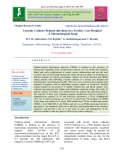
Catheter site (local) infection
-
Catheter-related bloodstream infection (CRBSI) is defined as the presence of bacteraemia originating from an intravenous catheter. It is one of the most frequent, lethal, and costly complications of central venous catheterization and also the most common cause of nosocomial bacteraemia. Hence the present study was undertaken to find the incidence of catheter colonisation, catheter site (local) infection and CRBSI among patients with indwelling vascular catheters in a tertiary care hospital and determine their microbiological profile.
 8p
8p  nguaconbaynhay6
nguaconbaynhay6
 23-06-2020
23-06-2020
 12
12
 1
1
 Download
Download
-
Central venous catheter insertion is a necessity while dealing with patients in MICU due to associated comorbid conditions. But following sterile barrier precautions while inserting and handling central line catheters is much more important as infectious complications take an upper hand if these “central line bundles” are not followed with great care. A prospective study was carried in a tertiary care hospital. The central line bundles while inserting the catheter with site and type was studied.
 8p
8p  trinhthamhodang4
trinhthamhodang4
 22-03-2020
22-03-2020
 17
17
 1
1
 Download
Download
-
In 2009, more than 370,000 patients were treated with maintenance hemodialysis in the United States.1 Hemodialysis patients require a vascular access, which can be a catheter or a graft or enlarged blood vessel that can be punctured to remove and replace blood. Bacteremias and localized infections of the vascular access site are an important cause of morbidity and mortality in hemodialysis patients.
 6p
6p  giamdocamnhac
giamdocamnhac
 06-04-2013
06-04-2013
 66
66
 6
6
 Download
Download
-
Diagnosis While the detection of CoNS at sites of infection or in the bloodstream is not difficult by standard microbiologic culture methods, interpretation of these results is frequently problematic. Since these organisms are present in large numbers on the skin, they often contaminate cultures. It has been estimated that only 10–25% of blood cultures positive for CoNS reflect true bacteremia. Similar problems arise with cultures of other sites. Among the clinical findings suggestive of true bacteremia are fever, evidence of local infection (e.g.
 4p
4p  colgate_colgate
colgate_colgate
 21-12-2010
21-12-2010
 58
58
 2
2
 Download
Download
CHỦ ĐỀ BẠN MUỐN TÌM
















